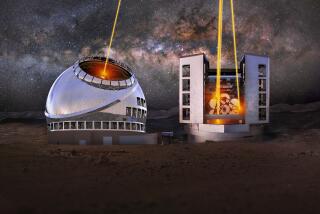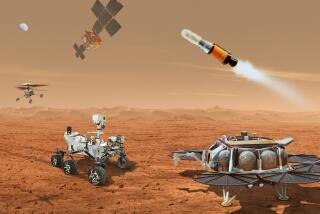NASA’s Webb telescope: Revolutionary design, runaway costs
- Share via
In deep, cold space, nearly a million miles from Earth, a giant telescope later this decade will scan for the first light to streak across the universe more than 13 billion years ago.
The seven-ton spacecraft, one of the most ambitious and costly science projects in U.S. history, is under construction for NASA at Northrop Grumman Corp.’s space park complex in Redondo Beach.
The aim is to capture the oldest light, taking cosmologists to the time after the big bang when matter had cooled just enough to start forming the first blazing stars in what had been empty darkness. Astronomers have long dreamed about peering into that provenance.
“It is the actual formation of the universe,” said Alan Dressler, the astronomer at the Observatories of the Carnegie Institution for Science in Pasadena who chaired a committee that proposed the telescope more than a decade ago.
If the James Webb Space Telescope works as planned, it will be vastly more capable than any of the dozen currently deployed U.S. space telescopes and will be a dramatic symbol of U.S. technological might. But for all its sophistication, the project also reveals a deeply ingrained dysfunction in the agency’s business practices, critics say. The Webb’s cost has soared to $8.8 billion, more than four times the original aerospace industry estimates, which nearly led Congress to kill the program last year.
The agency has repeatedly proposed such technologically difficult projects at bargain-basement prices, a practice blamed either on errors in its culture or a political strategy. Rep. Frank R. Wolf (R-Va.), chairman of the House appropriations subcommittee that controls NASA’s budget, said a combination of both problems affected the Webb.
“There was not adequate oversight,” Wolf said. “And there were reports that the cost estimates were being cooked a little bit, some by the company, some by NASA.”
It could spell a new era for the space agency, in which it will have money for just one flagship science mission per decade rather than one every few years as it has in the past. The Webb’s cost growth, along with an austere budget outlook for NASA, is depleting the agency’s pipeline of big science missions. A much-discussed mission to return samples of Martian soil to Earth, for example, may be unaffordable, according to the House Science Committee staff.
The Webb telescope was conceived by the astronomy community in the late 1990s as a more modest project with a smaller mirror for about $500 million. Then-NASA chief Daniel Goldin challenged the science community in a major speech to double the capability of the telescope for the same price.
Dressler, who was in the audience when Goldin gave the speech, recalled: “It astonished everybody. It made no sense that you could build a telescope six times larger than Hubble … and have it come in cheaper. We were so stunned, we didn’t know what to do.”
The early lowball cost figures had no official standing, but they shaped political expectations many years later.
Not surprisingly, the price began to rise, first to $1 billion and then to more than $2 billion when the aerospace industry began submitting estimates. By 2008, when the program was well underway, the cost hit $5 billion.
NASA was running into technical difficulties in manufacturing almost every aspect of the telescope, and it was forced to stretch out the schedule, said Richard Howard, NASA’s head of the Webb program and the agency’s deputy chief technologist. The agency kept investing in the most difficult technologies for the Webb, leaving other parts of the project out of sync. As a result, some components will be boxed up and stored for years while other pieces are completed.
The delays boosted the cost even more. By last year, the cost estimate to build the telescope hit $8 billion, not including about $940 million in contributions by international partners and about $800 million NASA will spend for five years of operation. The launch date slipped from 2014 to 2018, meaning an army of experts will have to keep working years more on the project. In the past, NASA could tap reserves in its larger budget to get through technical problems, but those funding pools have dried up, Howard said.
The skyrocketing cost infuriated many in Congress. Last year, Wolf led an effort by House Republicans to eliminate all of the Webb’s funding, though it was ultimately restored by a conference committee. But to those working on the program, the message was sent.
“It didn’t feel good,” said Scott Willoughby, Northrop’s general manager for the project. “It is costing more than it should. But we didn’t make any bad choices. The money was well-spent. We are building the telescope we originally conceived.”
Indeed, an independent review panel commended the telescope team last year for its technical merit. The machine has required a whole list of revolutionary developments.
The 21-foot-diameter mirror will be six times larger in area than Hubble, focused by more than 100 motors on its back. Made up of 18 hexagonal segments covered in a thin layer of gold, it is so big that it must be folded up for launch — another innovation.
To withstand the brutal temperature shifts in space and to save weight, the mirror is made of the rare element beryllium. Only a few companies in the world can polish beryllium so finely that mere atoms can be brushed off. One of those companies is L-3 Communications SSG-Tinsley Inc. in Richmond, northeast of San Francisco. The grinding and polishing process took seven years and required the company to build eight custom machines that cost $1 million apiece.
“We had to find a way to do this right,” said John Kincade, a vice president with L-3. “The mirrors have to be perfect.”
As ancient light traverses the universe, it shifts to the infrared region of the spectrum, requiring the Webb to have mirrors capable of collecting very faint emissions and detecting them with special sensors that must be kept at nearly the lowest possible temperature known to exist. The satellite will rely on four instruments, supplied by a European consortium, Canada, the University of Arizona and the Jet Propulsion Laboratory in La Cañada Flintridge, with other partners.
To achieve those low temperatures, the Webb will have a sophisticated refrigeration system and a five-layer plastic shade to shield the mirror and instruments from the sun. The shade will stretch to the size of a tennis court, keeping temperatures on one side at minus-388 degrees Fahrenheit and the other hot enough to fry an egg at 185 degrees. If it all works, not only will the Webb see the first light of the universe, but it will spot new planets and even determine whether those distant bodies hold water, Howard said.
Howard is confident now that the cost will not increase further and that NASA can execute the program on the new schedule. If the cost does go higher, Wolf admits Congress is not likely to kill the program but says NASA will get hurt in many other ways.
“The real danger is not that [the Webb] will not be funded, but it will consume so many other NASA programs,” he warned.








